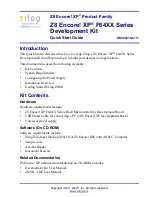S D B C - D K 3 U G
18
Rev. 0.3
Consider the following:
During the transmission of long packets, there is an increased chance that a disturbance may occur somewhere
along that packet—thus the need to implement good CRC checks.
During the transmission of short packets, there is an increased chance that the entire packet may be lost during
a disturbance—thus the need to implement more retries.
Transmission of long/short packets with a slow data rates have good easily recognizable 1's and 0's but by
comparison to fast data rates have a greater 'on time' and may use more power but retries may be less (in turn
saving power).
Transmission of long/short packets with a fast data rate may have a less 'on time' but retires may be greater,
antenna diversity may help reduce the multipath effects.
The trade offs in radio applications are many and the list above is by no means the only possible scenarios, every
application has its own list of acceptable trade offs and through the use of menu options such as data-rate, packet
length and antenna diversity engineers can learn to best understand what options work for them and their
environments.
7.1.6. Max Packets
So that designers can scientifically qualify the aforementioned trade offs, careful experimentation in applicable
application-like environments is recommended, the 'Max. Packets' menu option allows designers to select the
number of packets used to generate a Packet Error Rate (PER) result.
A large number of packets (1000–9999) allows for a good averaged result but can take time particularly at low
data rates.
A small number of packets (100) allows for a quick environmental assessment to be made prior to an
exhaustive test.
7.1.6.1. Example—Typical Usage
The designer will arrive at their test site and run a 100 packet test experiment prior to exhaustive testing. If the
results are in accordance with previous tests then the environment is similar to those of the previous occasion. If
there is a substantial difference in the results of a 100 packet test with any previous occasions results then new
environmental factors are playing into tests and these should be recorded as comments so that results from
exhaustive testing is better understood.
<Press the GO button>.
7.1.7. Screen 5: The Ready Screen
The ready screen on the LCD is the final step before starting your experimentation. The ready screen labels the
LEDs 1–4 according to the function they will perform. In this demonstration they are TX, RX, Antenna 1 and
Antenna 2. Note if you have disabled any of the antenna's or are using a none antenna diversity card then the
associated antenna is not represented by the LEDs.
Figure 21. Non-Antenna Diversity Testcard
Note:
Only one antenna highlighted on the top row and NO-ANTDIV shown in the second line of text.
Summary of Contents for C8051F930
Page 2: ...SDBC DK3 UG 2 Rev 0 3 ...
Page 9: ...SDBC DK3 UG Rev 0 3 9 Figure 5 MSC DBSB8 Schematic 2 of 2 ...
Page 21: ...SDBC DK3 UG Rev 0 3 21 Figure 24 Active Antenna and RSSI Indications ...
Page 23: ...SDBC DK3 UG Rev 0 3 23 Figure 26 Lab Equipment Connection Diagram ...
Page 75: ...SDBC DK3 UG Rev 0 3 75 NOTES ...


















